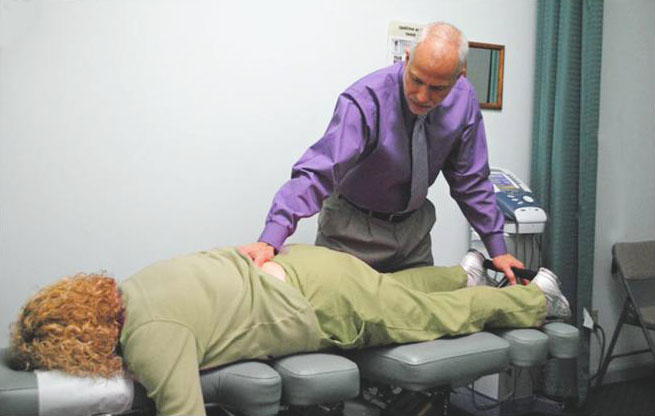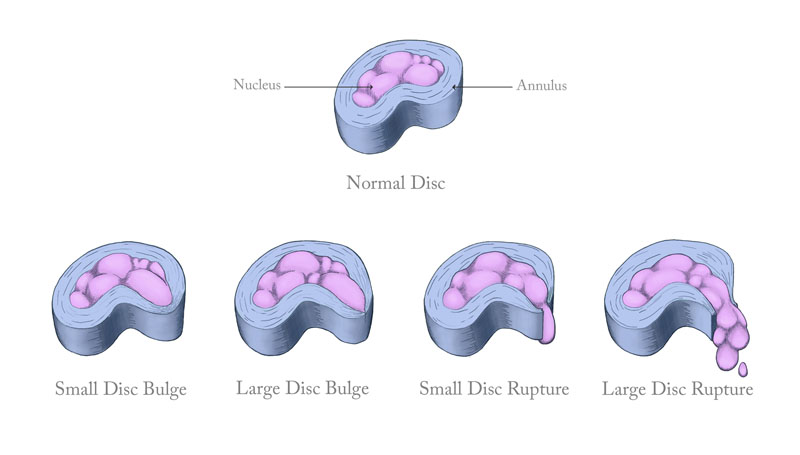History of Cox Spinal Decompression. Also known as "Cox Flexion Distraction", this method of manual spinal decompression or decompression by hand, has been researched and developed over the past 40 years by Dr. James Cox of Ft. Wayne Indiana, in conjunction with the National University of Health Sciences and Loyola Medical School. This method is a forerunner in the science of spinal decompression and is done “by hand” making it more specific and controlled than other “machine or computer operated systems” common in today’s health care market. During your spinal decompression sessions, the doctor will be the one administering and monitoring the treatment. He is trained to make sure you are comfortable throughout the entire treatment period.
How does Cox Spinal Decompression Work
Did you ever wish that someone could just “pull you apart”? Cox Spinal Decompression does just that, however it is designed to pull apart the involved disc only thus targeting the treatment exactly where it is needed. Cox Spinal Decompression doctors are trained in the proper diagnosis of lower back and neck disorders and will carefully evaluate your case to determine which specific disc level needs to be treated. This technique is gentle and involves no popping or cracking of the vertebrae as other Chiropractic methods do. The involved disc is gently stretched which encourages the inner contents of the disc to migrate back to the center thus reducing any bulging or protrusion. This results in reduced pressure within the disc and local nerves and encourages healing of the injured disc fibers that caused the bulge or protrusion in the first place.
 What is a Cox Spinal Decompression Treatment like?
What is a Cox Spinal Decompression Treatment like?
The video above demonstrates Cox Spinal Decompression being applied to a patient with a lower back disorder. You will be asked to lie comfortably on your stomach while the doctor gently contacts the involved spinal segment and stretches it within your comfort level. If you experience any pain during the procedure the doctor will use less “stretching force”. As your symptoms improve the doctor will use more “stretching force” ....always staying within your own comfort level. Although not demonstrated, Cox Spinal Decompression is done in a similar fashion to injured discs of the neck.
Researched Benefits of Cox Spinal Decompression
Federally Funded Research conducted by Dr. Ram Gudavalli PhD. in conjunction with The National University of Health Sciences and Loyola Medical School demonstrated the following four effects of Cox Spinal Decompression:
1. Reduction of pressure inside the disc
2. Increase in the overall height of the disc
3. Increase in the size of the openings where the nerves exit from the spine
4. Increase in the mobility of the vertebrae related to the disc being treated
All four effects are very desirable and assist in the overall healing process of the injured disc.
What is a spinal disc and how are they injured?
The spinal discs are oval shaped pads of cartilage that separate the individual bones of the spine called vertebrae. The discs act like spacers keeping the vertebrae far enough apart and providing sufficient room for the delicate nerves to exit from the spine. In combination with the spongy bone of the vertebrae they act like shock absorbers that help dissipate the various strains and stresses placed on the spine from our every day duties and hazards such as lifting, twisting bending, slips, falls and accidents etc.
 The disc has two components:
The disc has two components:
1. Outer rings of cartilage called the annulus (pictured right in blue)
2. Inner gel like substance called the nucleus (pictured right in purple).
The picture above shows the progression of injuries that can occur to the disc, each one being more severe as we go from the left to the right side of the diagram. Discs are injured when the outer (blue) fibers are stressed beyond their limits and tear. Cox Spinal Decompression has been successful in the treatment of these types of injuries, however not in every case. The doctor will be able to give you a prognosis for your individual case once he has examined you.
We will carefully evaluate your case and give you an honest appraisal as to whether or not this procedure will work for you.
How many treatments are necessary? (The 50% Rule)
Of course this will vary from individual to individual and from case to case however in order to be effective, treatment must begin at either daily for intense cases or every other day for less intense cases. We would anticipate that you will be approximately 50% improved within 30 days of starting treatment.
At any time the doctor feels that you are not progressing at an appropriate rate or that your case is deteriorating, you will be referred for a consultation to another appropriate health care provider, such as an Orthopedist or a Neurologist to get a second opinion of your case.
However if your case is progressing nicely, the frequency of your visits will be reduced when you are 50% improved and will continue to be reduced as you further improve.
How long does a treatment take?
The actual Cox Spinal Decompression only takes a few minutes however it is complimented with electrical muscle stimulation, the application of deep heat or ice, light massage, and light Chiropractic instrument adjusting procedures bringing the length of each treatment to approximately 30-45 minutes.
How long does it take to heal from a disc injury?
Research indicates that once healing begins it takes approximately 90 days for the disc tissues to heal so it is very important that you do not aggravate the healing process during this most critical time. In other words don’t do any home or work activities that would aggravate or re-injure the area especially during this time. Your doctor will advise you based on your case and your particular home or work responsibilities, what to do and what not to do to ensure the most rapid healing possible.
General suggestions that will promote healing of an injured disc
1. Don’t sit, it creates too much pressure inside the disc.
2. Don’t cough or sneeze, if you have to ....brace yourself against a wall
3. If constipated use a laxative, don’t push or strain on the toilet
4. Stay out of work for a while if your job duties aggravate your condition
5. Don’t lift anything heavier than a fork
6. Sleep on a good mattress, in a good position (find the sweet spot)
7. Use a good back brace, wearing it as tight as you can and as long as you can (up to 24/7)
8. Supplement your diet with a good glucosamine/chondroitin complex
9. Do your doctor prescribed exercises
10. Use appropriate cold/hot home therapy as prescribed by your doctor
11. Use analgesic rubs for temporary relief of pain
12. Keep your scheduled appointments
What is the difference between Cox Spinal Decompression and other forms of Spinal Decompression?
Cox Spinal Decompression is done by hand and by the doctor only. The doctor is always present and in full control of the procedure. The doctor is constantly monitoring the patients comfort level and adjusting the amount of “stretching force” based on the patients input. The other forms of Spinal Decompression presently on the market are done by computer animated machines with little or no doctor contact or consistent monitoring of applied forces. Cox Spinal Decompression treats the specific disc that is injured and that disc only. The other forms of Spinal Decompression treat all the discs of the lower back while attempting to direct most of the traction to the involved disc.
Research Findings on Cox Spinal Decompression
Close to 40 years of research, experience, and technology have contributed to the development and evolution of Cox Spinal Decompression Technique. Chiropractors, engineers, and researchers continue to document its benefits. For additional information about Cox Spinal Decompression Technique including available research click on the link below to go directly to the Cox Website. www.coxtechnic.com
Dr. Steven J. Garber – Dr. Garber is certified in Cox Spinal Decompression Technique. He has been using this system of Spinal Decompression since starting practice almost 30 years ago and even teaches it to the senior students at Life Chiropractic University in Marietta Georgia.
If you, or a loved one, are experiencing pain contact our office to schedule a free NO obligation consultation with the doctor or email Dr. Garber with a question concerning your case for a quick response. Garber Chiropractic Care Center 770-386-7707
Chiropractic Care and Pain Relief for Cartersville, Acworth, Taylorsville, White and Euharlee GA.
